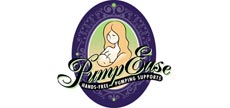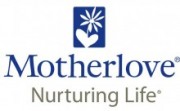By Bettina. Posted on August 5, 2010
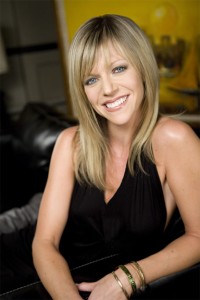 In honor of World Breastfeeding Week, we’re thrilled to bring you an interview with “It’s Always Sunny in Philadelphia“ Actress Kaitlin Olson. TV Guide says Kaitlin is “working an unconventional beauty-meets-bawdy vibe we haven’t seen (or enjoyed so much) since. . .Julia Louis-Dreyfus set the bar so high on Seinfeld.” Kaitlin appeared on the cover of the June 25 USA Today Pregnancy & Wellness Report that we participated in and is expecting her first child with husband and co-star Rob McElhenny this month!
In honor of World Breastfeeding Week, we’re thrilled to bring you an interview with “It’s Always Sunny in Philadelphia“ Actress Kaitlin Olson. TV Guide says Kaitlin is “working an unconventional beauty-meets-bawdy vibe we haven’t seen (or enjoyed so much) since. . .Julia Louis-Dreyfus set the bar so high on Seinfeld.” Kaitlin appeared on the cover of the June 25 USA Today Pregnancy & Wellness Report that we participated in and is expecting her first child with husband and co-star Rob McElhenny this month!
Because the theme of World Breastfeeding Week is the Ten Steps of Baby-Friendly Hospitals, we thought it would be great to focus on how to prepare BEFORE encountering the ten steps or lack thereof, so moms can set themselves up for success. Unfortunately, only 3% of maternity centers in the U.S. follow the 10 steps, and as a result, the 86% of moms who want to breastfeed aren’t making it past the first few days and weeks of exclusive or mostly breastfeeding-the CDC reports that most hospitals perform poorly on breastfeeding support. Moms are being booby-trapped by the very institutions that should be helping them the most! We want all moms to have a positive, empowering birth and breastfeeding experience, free of anguish and regret, whether they breastfeed for 2 weeks, 2 months, or 2 years!
1. How has your pregnancy been? How have you taken care of yourself during pregnancy? Studies show that the health of the mother during pregnancy influences birth & health outcomes for the baby.
I’ve actually had a delightfully easy pregnancy. I was lucky enough to not have any morning sickness, I worked all through my second trimester and half of my third with lots of energy, and I’m just now (at 9 months) starting to feel like I need to slow down and rest a little more. I’ve tried to take really good care of myself throughout the whole process. I drink tons of water and try to eat a low sugar, high vegetable, clean (1), healthy, organic diet. (I’ve also eaten a LOT of chocolate covered pretzels. I can’t help it.) I’m also walking like crazy. A lot more than I want to, in fact, but apparently that’s the best thing for toning my uterus and getting the baby in the right position. I also try to make sure I get enough sleep and stop to rest when I feel like I’m doing too much.
2. Why did you decide to plan a home birth? What influenced your decision?
I decided on a home birth because I believe that as long as a pregnancy is normal and complication-free, your body knows what to do and does not need medical intervention (2). I think the key to having a baby naturally is being able to completely relax and get out of the way of your body’s ability to get the job done. I believe I’ll be most relaxed and feel safest in my home (with an amazing nurse-midwife monitoring the baby and me the entire time, of course.) I was born at home and my mom has gone on to create Earth Mama Angel Baby, a company that makes safe, toxin-free products to naturally support pregnancy, childbirth, breastfeeding, postpartum recovery and new baby care. I grew up in this type of environment, so it’s very ‘normal’ to me. I want to be clear, though…I think hospitals are amazing, valuable places and I’m incredibly grateful to have access to Western medicine! I just don’t think that childbirth is a medical problem that needs intervention unless there is a complication.
3. What has been the reaction to your decision? Obviously, your mom is supportive; has there been any negative reaction or concern and how have you handled that?
Rob and I have had a lot of mixed reactions! Most of our friends have been very supportive because they know us well enough to know that we are the kind of people who do our research and make informed decisions. The people who panic and think we are crazy are the ones who haven’t done any research themselves. I don’t blame them, though. We aren’t really taught much about childbirth and labor in America. On t.v. and in movies, most of what you see on the subject are women screaming in pain and a lot of emergency c sections. The fact of the matter is that countries who’s standard is for women to deliver their babies at home with midwives have the lowest complication, intervention and infant fatality rates. The United States has one of the highest complication, intervention and infant fatality rates and we have our babies in hospitals. That’s hard for people to understand, but if you do a little research, it makes sense. Your body knows what to do in a pregnancy that has no complications. If you numb yourself and block your uterus’ ability to communicate with your brain, then lay down on your back and work against gravity, that can, sometimes, cause problems.
4. What tools or techniques are you using to manage the labor process and handle any pain or fear?
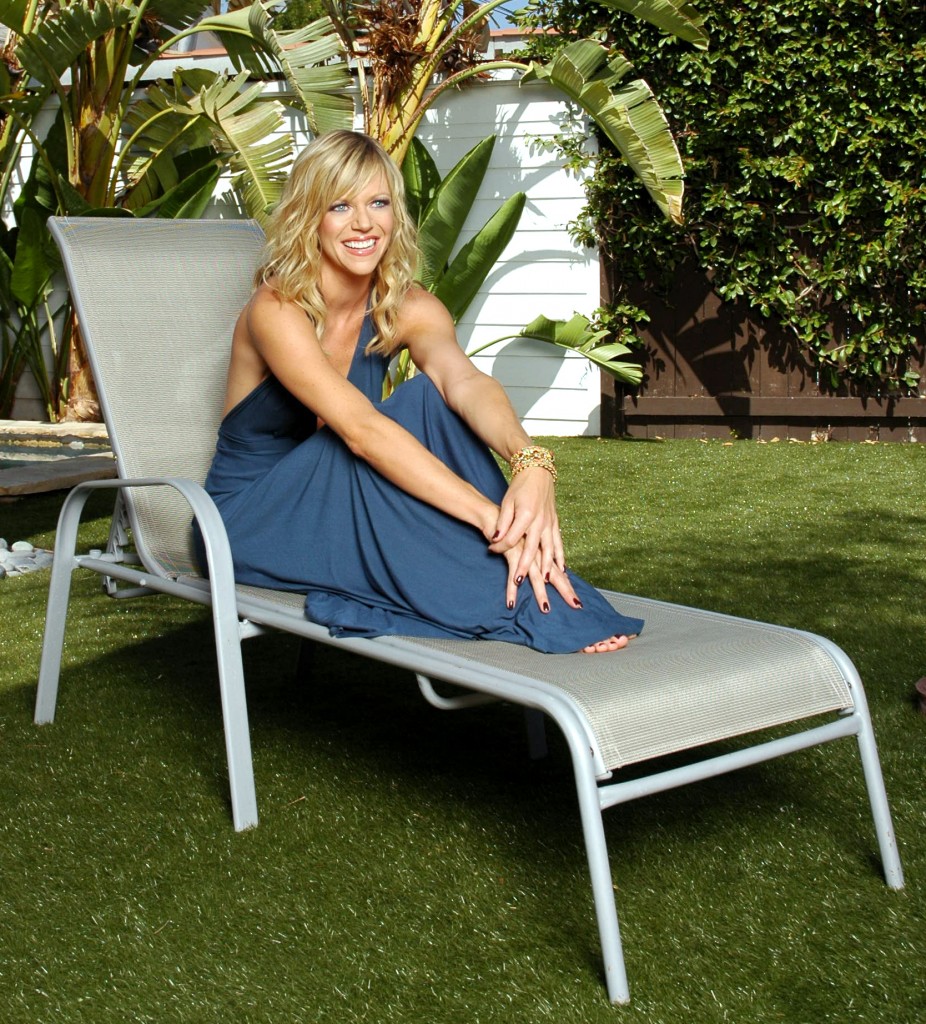 I’ve been practicing hypno-birthing for several months now. It’s basically training yourself to completely relax on command, allowing your uterus to do its job without tensing up in reaction to the pain, which just slows everything down. It also really focuses on eliminating fear, and I’m learning a lot about the correlation between fear and pain. When you’re scared, you tense up. That’s no good. Instead of being afraid of powerful contractions, I’m trying to focus on being grateful for them, because it means the baby is closer to being born. I also am using a doula who will be there to remind me of all of these things when I forget because I am in horrible pain.
I’ve been practicing hypno-birthing for several months now. It’s basically training yourself to completely relax on command, allowing your uterus to do its job without tensing up in reaction to the pain, which just slows everything down. It also really focuses on eliminating fear, and I’m learning a lot about the correlation between fear and pain. When you’re scared, you tense up. That’s no good. Instead of being afraid of powerful contractions, I’m trying to focus on being grateful for them, because it means the baby is closer to being born. I also am using a doula who will be there to remind me of all of these things when I forget because I am in horrible pain. 
5. Are you planning to breastfeed, and if so, what attracts you to it, for yourself, your family and for the baby?
Yes, I’m definitely planning to breastfeed! I just simply think that breast milk is the very best food for a baby. It’s also free. And takes no preparation or heating up (3).
6. Was your decision to have a natural birth influenced by studies that have shown an easier transition to breastfeeding? Birthing in a breastfeeding-friendly environment, i.e following the “Ten Steps”, makes a huge difference in breastfeeding initiation and continuation.
If we had decided to have the baby in a hospital, (or if for some reason we do need to transfer to the hospital during labor) I have done my research and am already very clear on what steps need to be taken in order to ensure that my baby and I have every opportunity to be able to learn together how to breastfeed. I don’t feel intimidated by nurses who may suggest that I need to supplement with formula or I am starving my child. In the spirit of staying positive, I am also not anticipating that I would get a nurse who is a bully or has harmful intentions. I don’t believe people in hospitals are bad people just because they have a medical background instead of a natural one. I just believe that different people have different views or different training, and I am not uncomfortable saying thank you, we’ve got it under control, and then bringing in a lactation consultant. I think it’s all about educating yourself, empowering yourself, and creating the best environment for yourself wherever you happen to give birth.
7. Have you prepared for breastfeeding in any way?
So far I’ve prepared by taking a breastfeeding class, watching a very informative video called Simply Breastfeeding by Shari Criso (4), and talking to my friends (and my mom) who have successfully breastfed their babies. We have a lactation consultant who will be coming over to the house when the baby is born and I’ve found a support group very close to my house if and when I need it. I think the best thing to do at this point is just jump in and see what happens and go from there, knowing that it’s possible that it comes very naturally, and also possible that I’ll run into problems but that doesn’t mean I’m failing! There are a lot of really wonderful resources out there if you go looking for them.
8. Have you encountered any “Booby Traps” to breastfeeding already?
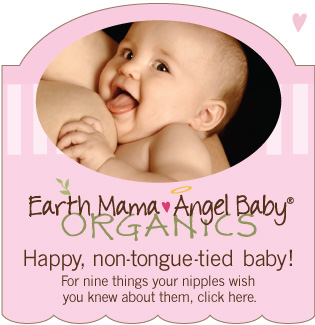
Earth Mama Angel Baby is a proud sponsor of Best for Babes
I have run into Booby Traps! I’ve heard from several friends who have tried to breastfeed and “failed.” Mostly the problem seems to be that they don’t think they produce enough milk. These are all very loving women who are good mothers and often they are being led to think that they are starving their babies and the best thing to do is supplement with formula. All moms come from a place of wanting to do the very best for their children! But it’s nice to know ahead of time that I have options. Earth Mama Angel Baby Milk Maid tea, Booby Tubes and Bosom Buddies all help with engorgement and encouraging milk to come in (5).
9. How have you dealt with any barriers to breastfeeding and how do you plan to handle any that come up?
You know, I’m just not really entertaining the option of a backup plan. I have lots of people in my life who have done this before to support me and really wonderful, knowledgeable professionals I can go to which makes me feel confident. Mostly at this stage when I start to have doubts, the best thing I can do is remind myself that my body was built to do this, and if I run into trouble I have a lot of options.
10. What advice do you have for expecting moms around taking care of yourself during pregnancy, and planning for birth and breastfeeding?
Educate yourself! Unfortunately that does not mean asking one person (your family doctor whom you’ve never questioned before), getting one answer, and then looking no further. I believe that how you take care of yourself in your pregnancy and the decisions you make regarding your birth, breastfeeding, etc. are all acts of parenting. The reality of our current state of health care, for better or for worse, is that a great part of it is being subsidized by major pharmaceutical companies and other special interests. Hospitals give you formula samples that are given to them by formula companies. That doesn’t necessarily mean that their products are “bad,” it just means that you may not be getting an objective point of view. So surround yourself with people you trust, ask lots of questions, listen to everything, and then make the most informed decision that you can. And eat chocolate covered pretzels, they make everything better.
Okay, Babes, do you have any questions for Kaitlin?
Best for Babes Resources & Tips
(1) For more information on ridding your home and your body of toxins, see Healthy Child Healthy World, a great non-profit, also The Smart Mama and The Soft Landing.
(2) To learn more about birth options, see My Best Birth
(3) . . . and is an all-around mom-made wonderfood.
(4) In celebration of World Breastfeeding Week, Shari Criso’s DVD is streaming FREE through September 30.
(5) Nursing more often builds milk supply. If mothers can’t or decide not to breastfeed, pasteurized, screened donor milk from a human milk bank, is the best substitute after expressing or pumping the mother’s own milk. Speak to your doctor about getting a prescription.
By Bettina. Posted on July 8, 2010
A while back we did a post on famous magazine covers and photos of celebrities breastfeeding. One of the commenters pointed out that it would be great if there were more pictures of celebrities nursing in public . . . magazine covers are great but if expecting moms saw more celebs breastfeeding in their every day lives, it would go a long way towards normalizing breastfeeding in our culture. We agree! Fear of nursing in public, and shaming, harassing or humiliating nursing mothers is a HUGE boobytrap in the United States.
Angela White, of the now defunct Breastfeeding 1-2-3, did a great post earlier this year with a beautiful gallery of celebrities breastfeeding in public or standing up for nursing moms. We want to build on this gallery and make a “home” for all the pictures that crop up in the media of celebrities breastfeeding. Sure, we all need to see more everyday moms nursing confidently in public, but we also know of more than one mom, husband, grandmother or friend who has changed their mind after seeing that a celebrity breastfed in public or spoke openly about nursing. Kourtney Kardashian is already blazing a trail with her open comments about breastfeeding and was seen pumping breastmilk on her TV show (warning-R rated for the language, and sexual suggestion, NOT for the image of a mother pumping, IMO).
http://mudspice.wordpress.com/” width=”128″ height=”120″ />As for everydaymoms, check out the awesome slideshow gallery created by Nursingfreedom.org to celebrate us everyday mamas and the beauty of giving our babies the breast and the best! A brand new organization, Nursingfreedom.org is running a fabulous carnival for nursing in public this week, we’ve been spreading the word and think they are doing a fantastic job.
Send us your links to pictures of your favorite celebrity moms breastfeeding in public, and we’ll make a permanent place for these pictures so more moms can find them and be inspired. We will be doing more celebrity interviews and will be using our influence to encourage celebrities that we speak with to nurse in public, and we’ll be using our influence with the media to persuade more mainstream ”coverage” (pun intended) of celebrities nursing in public . . . and will be adding those photos to a similar gallery. We know that moms need to see their peers nursing in public, but celebrities have a huge impact too. After all, if photos of Paris Hilton can spark a craze for carrying around dogs in purses, then surely a few more snaps of celebrities nursing can change the public’s attitude towards breastfeeding!
Photos of Celebrities Nursing in Public
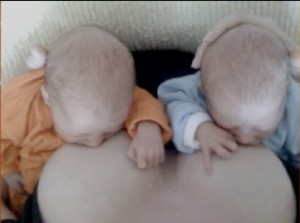
Julie Bowen Breastfeeds her twins, as seen on Lopez Tonight, courtesy of Huffington Post
Carrie Anne Moss in Star! Magazine
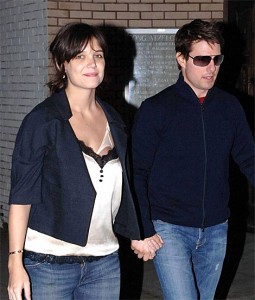
Katie Holmes famously reveals that the flap is down on her nursing bra or tank while out with Tom Cruise, courtesy Justjared.com
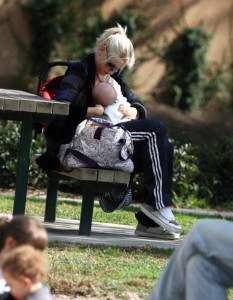
Gwen Stefani breastfeeding Kingston, image INFdaily.com
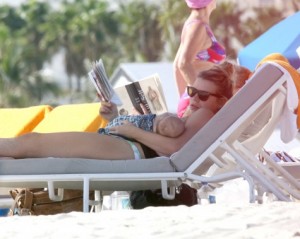
UK actress Billie Piper breastfeeding at Miami Beach, courtesy of INFDaily.com , I just had to put this one in because of all the furor recently over moms nursing at pools!
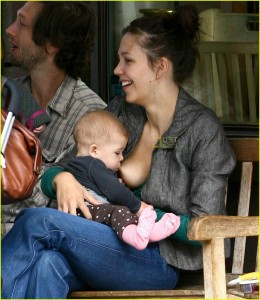
- Maggie Gyllenhaal, image justjared.buzznet.com Tea Leoni breastfeeding, Image Fame pictures
Our goal is to put together a complete gallery of celebrities breastfeeding in public, or showing their support for breastfeeding! And yes we’ll ask our awesome web guy, http://www.JoeDolson.com to help us make a pretty slide show. Please send us links to pics with credits for any we’ve missed.
By Elita Karma. Posted on July 5, 2010
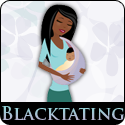
By Elita of Blacktating.com; for the Best for Babes Foundation ©2010
It’s officially summer and for a lot of folks, especially the rich and famous, that means family vacations. I’ve always loved these great tips for breastfeeding on a plane but in today’s times, you should also be aware of the TSA’s policies on traveling with breast milk. Unfortunately, you never know what will happen once you arrive at the airport as actress Jenna Eflman found out this week when TSA decided to “vapor test” her bottle of breast milk. Don’t you feel safer now?
There was a great discussion on my blog recently about the variations in care for breastfed newborn babies with jaundice. Some people had pediatricians who insisted on supplementing with formula, others were told to stop nursing, while some were told to nurse more frequently. Thankfully, the Academy of Breastfeeding Medicine has issued some updated, common sense guidelines for managing jaundice in a breastfed baby, which include initiating breastfeeding within the first hour of life and encouraging exclusive breastfeeding. Jaundice is incredibly common, which is why we have an extensive page on it.
Booby Trap Alert! As we told you this week, a new study done at the University of Florida on tongue tie revealed what many lactation consultants already knew: clipping a tongue tie could help many more babies to breastfeed successfully. Not only does there appear to be the sentiment amongst doctors that frenotomies are unnecessary, but unfortunately not all doctors are even allowed to do the procedure. See our post for tips on what you can do if you’re faced with this Booby Trap.
We know that most moms who stop breastfeeding say they did so because they weren’t “making enough milk.” Whether it was true or imagined, the concern is normal and valid. Although the percentage of moms who don’t make enough milk is small, if we think of it in terms of numbers, it is something that will affect many moms. Besides herbs and a drug called Reglan that can have some scary side effects, there aren’t really any legal options for women who need to increase their milk supply in the US. Dr. Thomas Hale and IBCLC Dr. Kathleen Kendall-Tackett would like to hear from moms who have used drugs to increase their milk supply, to help determine their efficacy and safety. If you’ve used Reglan or Domperidone, please take about 15 minutes to complete their survey.
Things were very busy on our Facebook page this week. First, because of you and your votes, we made it into the Top 200 charities eligible to win $20,000 from the Chase Community Giving campaign! We are also creating our own Babe Blogger Roll, so if you have a blog, please sign up and you’ll always have the inside scoop on what Best for Babes is up to.
This week, we asked you, the fans, what feeding norms you grew up with and you were overheard saying…..
Erica Bradley-McCabe I grew up with NO ONE breastfeeding. My first experience was my Swedish SIL breastfeeding my nephew when I was 18 and I decided to breastfeed but was very shy about it with my first.
Damian Dayton I only ever saw breastfeeding. When I got pregnant it was a no brainer that I, too would breastfeed.
Jorie Martin Roubitchek My first experience with formula was when I was babysitting at age 14. Before that, I had seen my mom and aunts breast-feed babies. I remember being really confused about what formula was FOR - but I was too embarrassed to ask the mom why they used that instead because I didn’t want her to be offended.
By Bettina. Posted on June 16, 2010
Hotly followed reality star Kourtney Kardashian is now writing a regular blog for People.com’s Mom & Babies and we’re thrilled about it!
In writing about traveling with baby Mason, Kourtney expresses every new mother’s anxiety:
At first, I was scared to travel with him. I’m sure every parent goes through it. You don’t know how your baby will be — what if he gets sick or his ears hurt from the pressure in the cabin? One travel tip I got from my doctor: He told me to nurse Mason during take off and landing. He also recommended I put some breast milk in Mason’s nose because it has antibodies that can help keep him from catching a cold on the flight.
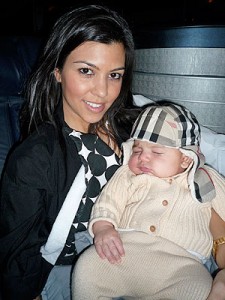
Kourtney Kardashian & Mason, courtesy of People.com
We love that Kourtney comes across as down to earth, and relates to expecting and new mothers, and doesn’t shy away from using this platform to share breastfeeding tips! For months now she has been systematically weaving her breastfeeding experience and tips into her tweets and her interviews with the press; sharing that it is “one of her favorite things.” This is exactly what moms need; to see nursing as a natural part of life that has its ups and downs and challenges, but comes with a lot of perks and is ultimately extremely rewarding. In the case of flying with a baby, it is down right convenient as there is less to carry, breastfeeding helps babies ears adjust to cabin pressure without over-feeding, and it keeps baby calm so other passengers can enjoy the flight too.
As is evident from the 103 comments on her post, Kourtney Kardashian has a remarkable opportunity to do more for breastfeeding than a whole bunch of government campaigns . . . she can help de-sensitize the squeamish (umm, she tasted her breastmilk), normalize breastfeeding in the public eye, and educate expecting and new moms, parents, siblings, grandparents . . . all through the highly visible media outlets. With her celebrity star-power, perhaps one day no mother will be kicked off a plane for breastfeeding.
Please tell People.com thank you for publishing Kourtney Kardashian’s breastfeeding tips and that we want more! Let them know that she is educating moms and boosting their confidence so that more moms and babies can benefit from the amazing health, economic and environmental gifts of breastfeeding. ( Important note: Even though many of you will notice and protest that Similac sponsors the Moms & Babies column, please keep your comments focused on the positive. We believe that we should reward People.com for moving in the right direction first, and we are also very grateful that People.com has graciously helped spread the word about our exclusive breastfeeding interviews with Gabrielle Reece, Kelly Rutherford and Alysia Reiner. Whenever People.com links to our interview we get hundreds or thousands of more hits on the story which means that we can reach and educate thousands of more people—there are some terrific breastfeeding-friendly editors working at People.com and we need them! Our hope is that eventually we can have a conversation with People.com about the WHO Code and help them find a more suitable sponsor that is truly helping moms and babies start out healthy . . . a sponsor that is not undermining parent’s informed feeding decisions and is not violating the World Health Organization’s International Code that protects moms and babies. For now, however, let’s focus on acknowledging People.com for including breastfeeding in their celebrity stories, and for working with Best for Babes!) Celebrity breastfeeding stories are critical to educating the mainstream and bringing about the cultural acceptance that we need so that all moms can achieve their personal breastfeeding goals. With millions of readers daily, People.com has an incredible opportunity to build on this trend and support the 86% of expecting moms who intend to breastfeed, and who are desperately trying to overcome the booby traps and follow the advice of the American Academy of Pediatrics to nurse exclusively for at least six months.
You can write People.com at editor@people.com or leave a comment on their Facebook fan page. You can also leave a comment on Kourtney’s post where she shares her breastfeeding tips . . . and please ask her to do an interview with Best for Babes! We’d love to hear more about her breastfeeding tribulations and triumphs and be able to share them in greater depth with our readers, along with our resources and tips as certified lactation counselors.
Thank you for helping us put positive pressure on the ”booby traps” by acknowleding media outlets that report on breastfeeding responsibly.
By Elita Karma. Posted on May 24, 2010

By Elita of Blacktating.com for the Best for Babes Foundation ©2010
Have you ever asked yourself, “Who benefits from all of this research conducted on breast milk?” It seems that we are constantly hearing about a new study touting the benefits of breastfeeding and breast milk and as as breastfeeding advocates, we get excited and forward the links to everyone we know. But who sponsors the research and why? We challenged readers not to believe every study they see, and in an excellent piece called Full Disclosure on the Academy of Breastfeeding Medicine’s blog, Dr. Alison Stuebe takes it a step further, examining how and why certain industries sponsor scientific studies.
Has anyone ever asked you, with eyebrow raised, if you were still nursing? Then you’ll love this piece by blogger Maria from Mommy Melee, who is still nursing and still is not ashamed!
Thought formula company marketing couldn’t get any lower? Then may I present you with Enfamil’s new chocolate formula for toddlers. The Atlantic did a great piece on the dangers of this product and is helping to raise awareness about the WHO Code. We’d love it if you could take a moment and post a comment thanking them. Although it’s important to call out the media when they get it wrong, we also have to remember to commend them when they get it right, so we can see more coverage of how dangerous this aggressive formula marketing really is.
Remember when actress Julie Bowen was on The View and they wouldn’t allow her to show a photo of her nursing her twins in the football hold? Well, she was a guest on the George Lopez show this week and he allowed her to show the photograph.
Beautiful!
If you’re a work out of the home mom like me, I know you can relate to some of the quotes from Vanessa Williams in this month’s Working Mother magazine. In the interview, Vanessa says, “There were definitely times I was torn and wished I could have stayed with my kids. There were times that it was very difficult. Just eight weeks after I’d had my second child, I had to go to England to promote my album for ten days. So I dragged my breast pump through airport security. I was so weepy to be leaving my newborn. Those were tough times.” As a mom who has done the same, I feel her pain, but kudos to Vanessa for making breastfeeding a priority!
Can breastfeeding protect babies from spiking fevers after immunizations? A new study shows that exclusively breastfed babies are 54% LESS likely to have a fever after being vaccinated. “When infants are sick and after a vaccination shot, they need not only water, food and a calm environment, but also to be protected,” said the lead author of the study. All things readily provided by breastfeeding.
Finally, Babes, we want to thank you for helping spread the word about Best for Babes on Facebook and getting us to our goal of 2,500 new “Likes,” and $2,500 from our sponsors. This week you were Overheard on Facebook talking about your nursing goals. You told us…
Dawn Davenport Covin with my first it was 1 year until I saw a lady (now friend) nursing an 18 month old and I asked myself why would I stop giving my baby my milk to give her cow’s milk? So, we went on to nurse for 26 months.
Claire Louise Hoyle I said 6 months and done!!! She self-weaned at 18 months and I was gutted!!! See how long we get second time as I have no goal……4 months so far….
Anna Caulkins Swank I never really set goals… always went with an “until they’re done” approach. That ended up being 10 months for Jonny, 20 months for Gracie, 18 months for Levi, and Reagan & Sera are still nursing at 22 months (and not showing any sign of stopping!)
By Bettina. Posted on May 12, 2010
A nude, expecting Demi Moore on the cover of Vanity Fair, captured by Annie Leibovitz, sparked a cultural acceptance of pregnancy and launched a booming maternity and “mommy & me” industry. Since that worked so well to mainstream pregnancy, would it work to mainstream breastfeeding? If so, how can we get more magazines to take the plunge and put breastfeeding pictures on the cover or in the issue itself? (By the way, Demi Moore, Christina Aguilera and Britney Spears all breastfed.) We think that such images would go a long way towards normalizing breastfeeding in our culture so breastfeeding mothers are not harassed for breastfeeding in public. Do you think it would help to reach the mainstream with more images that the mainstream relates to: slick, glamorous photos of celebrities?
Update: Just remembered that Eva Herzigova breastfed in the German Magazine Bunte, check out this fabulous post with lots of pix (scroll down for the breastfeeding ones) from Celebrity-babies.com in 2007, posted by breastfeeding-friendly founder Danielle Friedland. (She since sold the site to People.com and is now a certified lactation consultant!)
The image that launched a thousand ships and copycats
Christina Aguilera does Demi Moore
This version was on newstands only, subscribers got a less titillating cover.
Brad Pitt's photo of Angelina Jolie nursing one of the twins
Jerry Hall by Annie Leibovitz
By Bettina. Posted on April 14, 2010
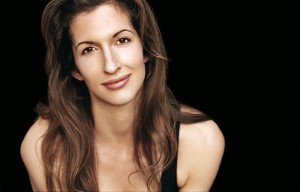
Actress Alysia Reiner & Best for Babes' New Champion for Moms!
Actress Alysia Reiner has inspired viewers with her film, tv and stage roles, including the films Sideways (for which she won a SAG award), and The Vicious Kind; guest appearances on 30 Rock, Law and Order (CI) and the Sopranos and numerous award-winning plays. Alysia is currently appearing in numerous film festivals with SPEED GRIEVING a short film she created, produced and stars in.
We were thrilled that Alysia approached us to help our cause; she is incredibly warm, grounded, and passionate about her craft and about helping mothers succeed. She is constantly looking for ways to help us raise awareness and beat the “Booby Traps”. We are proud to designate Alysia Reiner as our latest Champion for Moms! By sharing her breastfeeding story exclusively with us, she knew we would be able to get more evidence-based, accurate information and resources into the hands of expecting and new mothers (we’re both Certified Lactation Counselors). She was also quoted in the USA Today story about the gift of donated breastmilk for mothers who are struggling with breastfeeding (or can’t breastfeed or decide not to breastfeed) and who want the next best substitute for their own milk—milk donated by another mother.
Best for Babes: Who or what inspired you to breastfeed, and to stick with it?
Alysia Reiner: I always thought it was such a mysterious and magical thing that women can do and always knew I wanted to try, my mom wasn’t able to, but I had heard it wasn’t as easy as one may expect - and then I found YOUR WEBSITE! When I found it and read the incredible article about the amazing benefits of breastfeeding, your inspiring interview with Gabby Reece, and maybe most important the BOOBY TRAPS which helped me prepare.
BfB: That is so cool that our interview with Gabby inspired you! Did you seek out breastfeeding advice during pregnancy? From where or whom?
AR: I went to a great class at Golden Bridge Yoga in LA, I got some helpful videos, read a bunch of books and had a lactation consultant’s number ready for after birth. I had enough friends have trouble that I knew it wasn’t as ‘natural’ as one may imagine.
BfB: What kind of birth experience did you have, and how did it impact breastfeeding? Did you have a “breastfeeding-friendly” ob-gyn, birth center/hospital and pediatrician?
AR: I gave birth in a birthing center, had fantastic midwives and an amazing doula - all which helped me so much because they were all very breastfeeding oriented. In fact at the center they took the bag filled with formula that they are supposed to give me, dumped all the formula and gave me blankets, witch hazel pads & and Lansinoh instead. My pediatrician is very breast feeding friendly, and even though Liv is a year now she encouraged me to breast feed Liv through the winter because it would be such a nasty flu season. Essentially I built a base of cheerleaders.
BfB: Who or what helped you the most during the learning curve of the first few weeks?
AR: My doula was amazing, and my friend Catherine who has 4 kids and breast fed them all, came over and set me up in the most amazing way. Everyone checked our latch a lot and all the research I did came in handy but David was my biggest cheerleader. He would encourage me and really educated himself to help (like supporting me and knowing I wasn’t crazy when I would take Liv off to get a good big mouth latch). He would write down feeding times, bring me water & food, he was so amazing.
BfB: Has breastfeeding detracted from or enhanced your relationship with your husband in any way?
AR: I think honestly he is in AWE so that’s always good. But seriously, becoming parents has so many deep ramifications on a relationship, it is hard to pin point what is connected to what. In general I would say he is just thrilled by it, it really is such an incredible thing our bodies do - that you can feed another human being nothing but this extraordinary liquid and see a human being grow and thrive! He is thrilled to see it and see the bond between Liv and I. Is he jealous sometimes? Sure. Have there been a few embarrassing intimate moments? Yep. He has to share my body, and a very special part of it, that he probably wishes he didn’t have to share sometimes but in general I think we both feel it’s worth it.
BfB: What do you like/love about breastfeeding?
AR: The closeness with Liv. Being able to soothe, comfort and make her feel safe and loved. I will be sad to give that up someday but she loves to hug and snuggle so much now. I also LOVE knowing what is going into her body. I have been so careful about food, additives, chemicals, because I am her source of nutrition, and that feels so good. I have gotten so healthy. Show me the wheat grass and super foods! And Liv is a great eater, LOVES veggies and I do wonder if it is because I have been so green in my eating. [BfB Note: Dr. Alan Greene says breastfeeding exposes babies to thousands of flavors!]
BfB: Has this experience been different in any way from what you expected? Any obstacles along the way?
AR: I didn’t expect to love it so much. To feel so miraculous. To do it so long. I thought I would stop when she could ask for it but then she started talking really early - oops. The obstacles were: the first month is HARD - just getting used to it, regulating your flow, pumping, all of it. Again girlfriends helped so much. Now it’s so easy.
BfB: What is the most unexpected gift you have received from breastfeeding Livia?
Being able to give my milk to another mother. I didn’t even know if I would be a make enough for one baby, as a small breasted woman I was actually very concerned about that (as it happens size has nothing to do with milk production). I have a lot in storage just in case of emergency and never needed it, so I started looking into donating it to a milk bank. At the same time I spoke to a friend who was having a very hard time with breastfeeding, and suggested she look into milk banks. Then it dawned on us both that it might be easier to just do a direct donation, similar to when you direct an organ donation or direct a blood donation. So I am happy to be able to share my milk with another mom’s baby. Feeding Liv is heaven and such a gift, but sharing my milk was the most incredibly unexpected gift of all.
*Best for Babes Note: Although milk-sharing and cross-nursing have gone on since the beginning of motherhood, any exchange of bodily fluids carries a risk of transmitting communicable diseases such as HIV, hepatitis, etc. and mothers and babies have died from the transmission of diseases. (Salma Hayek cross-nursed another baby in Sierra Leone but we suspect (and hope) that both she and the baby were tested first, as it is possible for the baby to transmit disease to another mother!) For that reason, we strongly caution against direct donation and recommend that mothers wishing to donate milk or needing donated milk contact the Human Milk Banking Association of North America (HMBANA). HMBANA is celebrating its 100th year of SAFE, RELIABLE milk banking and we hope that someday that ALL mothers who can’t breastfeed, choose not to breastfeed, or whose babies are medically indicated for supplementation will have access to human milk from a registered milk bank, the superior, preferred substitute for direct breastfeeding or pumped breastmilk from the mother . HMBANA ensures that all milk is properly handled, screened for diseases, and pasteurized before it is given to another baby. Only if moms demand this superior substitute will it be made more available.
BfB: How did you juggle breastfeeding and going back to work? Did you run into any “Booby Traps“?
AR: I was super lucky going back to work. In the first couple months, I did a workshop of a new play, and the producer & director were both moms who accommodated the schedule to Liv’s feeding schedule. My amazing husband brought Liv to the rehearsals, and the studio we were rehearsing at gave me a lovely private room to feed her in. Next I worked on some TV shows, all of which gave me an extra room or more roomy trailer so I had room for Liv’s stuff, her car seat/stroller and a warm cozy spot to feed her. The crew were great about communicating to me about the schedule so I could plan her feedings around shots. I am so grateful to them all because I know that is not always the case. Now I am running around to festivals with my film ( SPEED GRIEVING - join our facebook fan page!), and it’s much easier because she feeds so much less often, and again my husband had been incredible about helping make it work.
I think for me it was such a diplomacy game. It was so important to explain right off the bat that I love to work, I am grateful to be invited to collaborate as an artist, AND this was a priority for me (just to be clear, even though I did pump and that was available to her just in case I wasn’t available, it was always my preference to be with her), AND at the same time be clear that I am a professional and I will show up as such - it’s such a balance.
BfB: Experience is the best teacher. Is there anything you learned along the way that you are inclined to share with her moms?
AR: 1) BE PREPARED: EDUCATE YOURSELF AS MUCH AS YOU CAN BEFORE YOU HAVE THE BABY.
2) HAVE SUPPORT & CHEERLEADERS.
3) KNOW THAT THE FIRST FEW WEEKS ARE ROUGH, BUT IT REALLY DOES GET EASIER.
BfB: Thank you so much for that awesome, perfect advice, and for helping us inspire, prepare and empower more moms!
Best for Babes Notes for Moms:
1. Tips for expecting moms: Find out what inspires and motivates you to breastfeed, and prepare yourself for breastfeeding by reading The Learning Curve of Breastfeeding and the Ultimate Breastfeeding Checklist to hit the ground running!
2. The Right Gear: While all you really need for breastfeeding is at least one boob and a baby, here are our 4 top must-haves: the Simply Breastfeeding DVD, the Earth Mama Angel Baby Breastfeeding Support Kit, a My Brest Friend breastfeeding pillow, and a comfy chair with a stool (or a stack of books in a pinch). Chances are you already know about having a comfy, non-underwire nursing bra or tank top.
3. Your birth experience can dramatically impact your breastfeeding experience and success. Read Your A-Team to find out what you should ask your hospital and physicians about breastfeeding to know if you will get real help or just lip service.
4. Demand Donor Milk: Only if moms start requesting donor milk from a registered milk bank will it be made available! Too many doctors don’t even know about it, too many hospitals don’t carry it. Start spreading the word about this superior substitute for a mother’s own milk. Hopefully you won’t have breastfeeding problems, but if you do, you deserve the best supplement-pasteurized, screened, donated human milk from a milk bank.
5. Going Back to Work: Read great info and tips on going back to work, and an inspiring story on starting a corporate lactation program.
Special thanks to People.com for spreading the word about this interview.
By Bettina. Posted on December 22, 2009
Under the influence of the holiday spirit, (and late nights of deranged cookie-baking) I re-wrote the 12 Days of Christmas to reflect the Best for Babes vision of what it would take to really help moms. I’ve explained below why each of these gifts would rebuild our shattered breastfeeding infrastructure, and contribute to a world where all mothers who want to breastfeed could meet their personal breastfeeding goals without pressure, judgment or guilt. Moms, babies, our society and the planet would benefit.
Before you continue reading, click on the image to the right, and go ahead and sing it! It’s more fun when you actually do it. It may take a bit of nimbleness, but I tried it out on my kids and husband, so can vouch that it is sing-able.
(As Dr. Seuss might put it, you can sing it to your hospital, doctor, employer and store, sing it at the mall, they’ll ask for more! Sing it far and sing it loud, sing it to the squeamish crowd. Sing it at your breastfeeding meeting, sing it as a friendly greeting. Sing it to help moms succeed, and fulfill every breastfeeding need!”)
Print-out version of Best for Babes’ Breastfeeding Days of Christmas
How 12 Gifts Would Rebuild Our Shattered Breastfeeding Infrastructure
A mother wanting to breastfeed: 74% of mothers want to breastfeed and are trying to breastfeed, but only 40% are achieving their personal goals, and only 12% are making it to the American Academy of Pediatric’s minimum recommendation of six months exclusive breastfeeding. Even worse, most moms are not even getting through the first few days or weeks of exclusive breastfeeding, and it is not their fault. Moms are being pressured to breastfeed but set up to fail by insidious “booby traps”-cultural and institutional barriers. It is as bad as telling someone to run a race and handing them flip-flops. For more about awful mixed messages we are giving moms, see this excellent article by babygooroo.com.
Two doula/midwives: Having a labor doula or midwife can lower the risk of a c-section, reduce labor time, perception of pain, and generally provide superior birth outcomes, which lead to better breastfeeding initiation. Many ob/gyns and hospitals welcome the participation of a labor doula as it makes their job easier, think of it as an experienced coach who can help you way more than your husband/partner, who in all likelihood, has never delivered a baby.
Three support groups: La Leche League is the largest and best known mother-to-mother support group provider; there are also support groups springing up through IBCLCs, Maternity and breastfeeding boutiques, and hospitals. Shop around, not all support groups are created equal and word of mouth will lead you to the best ones. Support groups that are judgmental or do not provide accurate, scientifically-proven information are a hidden “booby trap.”
Four (FABM) MDs: FABM stands for a Fellow of the Academy of Breastfeeding Medicine, and means that this physician has demonstrated advanced knowledge and skills in breastfeeding and lactation management (read between the lines: this doctor is not just giving “breast is best” lip service while handing out formula samples and undermining moms). Similar to FAAP (Fellow of the American Academy of Pediatrics) it follows the physician’s credentials, e.g. Caroline Chantry, MD, FABM . We dream of a day when not just Ob/Gyns and pediatricians are FABMs, but allergy, diabetes, heart disease and other specialities that are impacted by increased breastfeeding rates. When an expecting mother sees her allergist, he/she should be encouraging her to breastfeed, and discussing it in a supportive, evidence-based framework! For more on choosing a breastfeeding-friendly physician, click here.
Five Baby-Friendly Hospitals: This is a biggie, which is why it goes in the “5 golden rings line.” Only 3% of the 3,000 maternity and birth centers in the U.S. are designated “Baby-Friendly” under the Baby-Friendly Hospital Initiative. The Centers for Disease Control found that 70% of hospitals perform poorly on breastfeeding support; no wonder moms are not making it through the first few days! If all maternity & birth centers followed the ten steps to Baby-Friendly, such as rooming-in, latching the baby in the first hour, avoiding pacifiers and bottles, providing donated, screened, pasteurized human milk from a milk bank if supplementation is needed, and not handing out gift bags filled with formula samples (shown to reduce breastfeeding duration), we’d see a meteoric rise in breastfeeding rates (and population health improvement, and employee morale, and reduction in carbon emissions, etc.-we could go on and on). Moms are being “booby-trapped” by the hospitals they trust, and it has got to stop. Let’s move the nurse-ins to the hospital lobbies, and start writing respectful, but firm letters to hospital CEOs and copying them to the media.
Six great IBCLCs: An IBCLC is an International Board Certified Lactation Consultant. To find the best ones, click here, and be aware that like in every other field, there are some quacks. If your “lactation specialist” in the hospital is judgmental, grabs your boob, hands out nipple shields like candy, or otherwises raises your finely-tuned mom’s instinct antennae, call your La Leche League group, friendly doula/midwife, or local breastfeeding boutique for the name of a good one that can visit you in the hospital. We urge you to complain to the CEO of your hospital if you have a negative experience, and write a letter of commendation if you were helped. Copy it to your local newspaper.
Seven partners protecting: The role of your partner or spouse in protecting the breastfeeding relationship when a mother is at her most fragile and vulnerable is invaluable. Forget sending him or her to labor classes (get a doula instead); make sure your husband or partner is educated about the hospital booby traps and is ready to bare their teeth to all the insidious attempts to derail your breastfeeding efforts. This is where he/she can really be your hero.
Eight friends a-helping: Not only should your friends cheer you on for your decision to breastfeed, they should line themselves up to cook, clean, babysit your toddler, grocery shop and run errands for you. Your job is to rest and to get the hang of breastfeeding, you are an athelete in training with a single focus. Entertaining guests is for later!
Nine celebs a-nursing: Celebrities are hugely influential in our celeb-obsessed culture, and can have a positive influence on the many women who have few or no breastfeeding role models. After Angelina Jolie’s breastfeeding cover on W magazine, many women wrote that if she could nurse twins, they felt empowered to do it too. We also need more celebrities to talk about more benefits of breastfeeding than just losing weight, and share their intimate breastfeeding stories in our context of helping moms (see our interviews with Kelly Rutherford and Gabrielle Reece). We need celebrities to nurse in public to show solidarity with moms who face huge social disapproval for nursing discreetly, or are outright discriminated against. We need celebrities to lobby for the Breastfeeding Promotion Act, and increased funding for breastfeeding infrastructure . . . in short, breastfeeding needs a Bono, Fox, Gere or Gore. Salma, Angelina, Gwyneth, Sigourney: we need your help!
Ten nursing nooks: Boy are we tired of hearing about moms who are thrown out of stores, restaurants and even airplanes for breastfeeding. It’s really getting old. And just for the record, most moms prefer to be discreet, but some babies yank those blankets right off. Wouldn’t it be great if every mall, every shopping plaza, and every airport had a cozy nursing lounge (i.e. NOT the bathroom)? And every store and restaurant had a quick and easy supportive breastfeeding policy? We’re working on it, and have an exciting platform, but we need your help to raise the funds to make it a reality. We’d love it if big breastfeeding-friendly retailers like Nordstrom would sponsor it; and it would help the image and PR of Target, Applebees, Victoria’s Secret and Starbucks if they would jump on board too. Did we mention that 74% of moms try to breastfeed? That’s at least 3 million moms per year, and billions that have ever breastfed!
Eleven strangers cheering: Best for Babes is working to change the breastfeeding culture in the United States so that the public not only accepts breastfeeding, but thinks it’s cool, hip and fabulous. This takes giving breastfeeding a makeover and branding and “marketing it to be as mainstream as motherhood itself”. This does not mean the overbearing lecture to moms on all the benefits of breastfeeding, it means setting a positive example and attracting women to breastfeeding so they are psyched and pumped up to breastfeed, much like working out or making any other lifestyle change! Face it, we all need a little motivation (benefits are great, but a cute workout suit can help too) to get to the gym, and breastfeeding is no different: some helpful information, some stellar breastfeeding products that make it more fun and a little easier can go a long way. Most of all, it takes a culture that adopts the Best for Babes credo of cheering on, coaching and celebrating ALL moms to make informed breastfeeding decisions, and achieve their personal breastfeeding goals whether it is one week one month or one year or not at all. We need to gently lower the defensiveness of women who didn’t breastfeed or couldn’t breastfeed by ending the horrible cycle of pressure, judgment and guilt. Like seatbelts and sunscreen, our mothers didn’t know better. Many of our peers were “booby-trapped” by the barriers, and feel awful about it, and are blaming themselves not realizing they were set up to fail. Some moms truly can’t breastfeed-how do you argue with a double mastectomy, or medication contraindicated by breastfeeding, or having tried everything to no avail? If 95% of women are capable of breastfeeding successfully, there are still 5% that are not, no matter how many IBCLCs they see. Another reason we need more milk banks! Most importantly, ALL moms deserve compassion and respect. With a little TLC for all, we’ll find the “breast vs. bottle” debate and the mommy and boob wars will lose steam and that even the moms who decided not to breastfeed or couldn’t breastfeed because of barriers will start cheering moms on. Case in point: My co-founder’s mother, who didn’t breastfeed her daughter, is one of our staunchest supporters. My special request, please read these two articles if you are a breastfeeding advocate (hint: become a mom advocate first): “Shame and the Mom: A Boob Story” by herbadmother.com, and “When Boobs Collide” by Hisboyscanswim.com.
Twelve supportive employers: This is last on the list because the reality is that most new moms are not making it past the first few days and weeks of exclusive breastfeeding, long before their maternity leave ends and they go back to work. (Oh yeah, and we have some of the worst maternity leave policies of any industrialized nation, so let’s assume that not all mothers even get maternity leave, unlike most European countries with high breastfeeding rates that provide a year or more. Some companies provide 3 months but that is not enough.) But the specter of having to fight for the right and the breaks to pump on the job, be sneered at and harassed, and have no place to pump besides the bathroom or a dirty closet with an outlet, can discourage many working moms from trying to breastfeed in the first place. And the ironic kicker? Breastfeeding benefits a company’s bottom line; less sick days used, lower employee turnover, higher morale, lower benefits expenses, better attraction of qualified employees, the list goes on. Go figure.
By Bettina. Posted on December 17, 2009
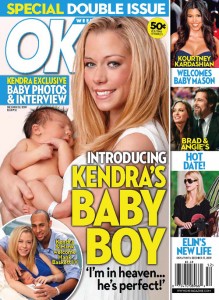 Reality TV star and former Playboy model Kendra Wilkinson is successfully breastfeeding, despite her initial fears. (You may remember that US magazine reported that both Kendra Wilkinson and Kourtney Kardashian were concerned they would not be able to nurse their babies because of breast implants received at a young age.) While the full story in the December 17 issue of OK! magazine does not mention breastfeeding (and states that husband Hank gave baby the first feed), we’ve been told by a spokesperson that Ms. Wilkinson started breastfeeding on the second day and is very happy to be nursing her baby.
Reality TV star and former Playboy model Kendra Wilkinson is successfully breastfeeding, despite her initial fears. (You may remember that US magazine reported that both Kendra Wilkinson and Kourtney Kardashian were concerned they would not be able to nurse their babies because of breast implants received at a young age.) While the full story in the December 17 issue of OK! magazine does not mention breastfeeding (and states that husband Hank gave baby the first feed), we’ve been told by a spokesperson that Ms. Wilkinson started breastfeeding on the second day and is very happy to be nursing her baby.
Ms. Wilkinson got quite a bit of publicity for sharing about her fears. We wrote about it, offered some breastfeeding advice and a shopping list, and extended our cheers to Wilkinson, Kourtney Kardashian and US magazine for helping to change the public perception of breastfeeding and making it more mainstream. Soon after, we noticed an increase in the number of articles talking about implants and breastfeeding, which is wonderful! More surgeons who are performing breast augmentation and reduction surgeries need to know about procedures that preserve the milk ducts, and it should be standard protocol to discuss those options with patients in their childbearing years. More mothers who are planning to breastfeed deserve access to evidence-based information about breastfeeding with implants so they can prepare and plan accordingly.
Congratulations to Ms. Wilkinson for overcoming one of the earliest “booby-traps”-fear of breastfeeding due to misinformation. On behalf of all the moms and babies we serve, we thank her for raising awareness of this important health issue. Celebrities who share their personal breastfeeding stories, like Kelly Rutherford and Gabrielle Reece, help us cheer on, coach and celebrate moms to achieve their personal breastfeeding goals without pressure, judgment and guilt, and to get evidence-based and inspiring information into the hands of more moms. This is an exciting and wonderful time in a new mother’s life and we want all mothers who decide to breastfeed to have a positive breastfeeding experience!
By Bettina. Posted on October 12, 2009
There are an ever growing number of breastfeeding books coming to market, some that are more evidence-based than others, some that are more user-friendly than others, some that bring a much needed sense of humor. All come with the intention of helping mothers to succeed at breastfeeding.
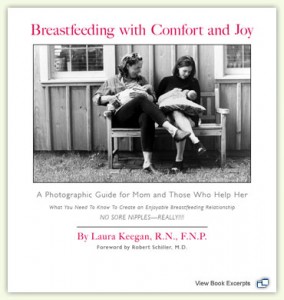 And then there is Laura Keegan’s book, Breastfeeding with Comfort and Joy: A Photographic Guide for Mom and Those Who Help Her which can be ordered exclusively at http://www.thebreastfeedingbook.com. (Enter giveaway below!) There are many ways that this book is different from all the others I have seen; and not just because it has almost as many photographs as it does words. Uniquely, this book unfolds in lustrous images and reassuring words, page by page, drawing the reader in soothingly, much as a new mother draws her baby close for comfort and sustenance. It is easy to read in one sitting; in fact I could not stop. I was as mesmerized by the language as I was by the photos, most of which were taken by the author. I still get goosebumps from the photo on page 2.
And then there is Laura Keegan’s book, Breastfeeding with Comfort and Joy: A Photographic Guide for Mom and Those Who Help Her which can be ordered exclusively at http://www.thebreastfeedingbook.com. (Enter giveaway below!) There are many ways that this book is different from all the others I have seen; and not just because it has almost as many photographs as it does words. Uniquely, this book unfolds in lustrous images and reassuring words, page by page, drawing the reader in soothingly, much as a new mother draws her baby close for comfort and sustenance. It is easy to read in one sitting; in fact I could not stop. I was as mesmerized by the language as I was by the photos, most of which were taken by the author. I still get goosebumps from the photo on page 2.
Although the photos-which are unapologetically graphic-do tend to take center stage, the text is a worthy match. The introduction lays out the intention of the book to clear away the chatter of breastfeeding war stories we’ve all heard before, and to remind us that breastfeeding can actually be incredibly wondrous and enjoyable if moms are given the right support. This concept is very much at the heart of what Best for Babes is all about-breastfeeding has been made far too difficult by a gauntlet of “booby traps” that keep moms from succeeding, despite their best intentions. We believe that no one should tell moms what to do, but for pete’s sake, if she wants to breastfeed, let her succeed! As long as 60% of moms are being prevented from achieving their personal breastfeeding goals by our disapproving culture and by hospitals, physicians, employers and insurers, it will be hard to get breastfeeding continuation rates to go up-only 11% are making it to the minimum 6 months recommended by the AAP. As long as moms are struggling unnecessarily and not enjoying the breastfeeding experience they will pass on their horror stories and dissuade their peers. We can do better for moms!
There is a surprisingly large amount of evidence-based information packed in to a small space. There have been other excellent reviews (see the Motherwear Blog) of the lactation science in the book, and I defer to experts such as Tanya Lieberman, IBCLC. However, I was very interested and happy to see the context Keegan established about “bottle-feeding imprinting” and how our culture interferes with mother’s natural nursing instinct. I enjoyed how she succinctly explained skin-to-skin contact and the work of Lennart Righard, as well as the mother’s amazing ability to regulate her temperature to warm up her baby, even on command. As someone who is squeamish about breastfeeding at heart, I did gulp at some of the photos, but I think they are incredibly important for helping moms get comfortable with their bodies, and they are needed to help change our culture. Most of all, though this book wants us to fall in love with breastfeeding, and I did, in a way that I didn’t get a chance to experience when I was going through it myself. For an expecting mother or new mother, I can’t think of a better gift.
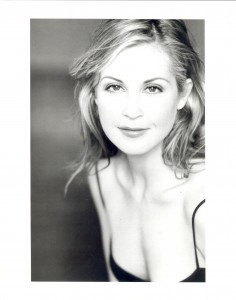 I am especially pleased to be able to share actress Kelly Rutherford’s endorsement of the book as well. Kelly has been very outspoken about breastfeeding, sharing her story openly with us and using her celebrity status as a star of “Gossip Girls” to raise awareness and appreciation of breastfeeding, and helping us shift the pressure off moms and on to the “booby traps”. Here is what she had to say about Breastfeeding With Comfort and Joy:
I am especially pleased to be able to share actress Kelly Rutherford’s endorsement of the book as well. Kelly has been very outspoken about breastfeeding, sharing her story openly with us and using her celebrity status as a star of “Gossip Girls” to raise awareness and appreciation of breastfeeding, and helping us shift the pressure off moms and on to the “booby traps”. Here is what she had to say about Breastfeeding With Comfort and Joy:
Breastfeeding with Comfort and Joy is amazing. I received the book while I was pregnant with Helena, and it was a gift that touched my heart. This book could be given at baby showers and available at every place we bring babies. I would like to see it at hospitals caring for moms and babies and at every pump station in LA!!
Breastfeeding with Comfort and Joy celebrates our ability to nurture our children. The book is an extremely practical breastfeeding guide, but also gets us back to what it means to nurture through its words, images, and helpful ideas. It teaches women about breastfeeding in a non-threatening way, respecting that every breastfeeding mother and baby pair is unique, facing different circumstances in their lives.
All of the women in this book are different, but all are nurturing their babies; some with babies feeding at moms’ breasts, others just cuddled close to mom (or dad). When we come from a place of nurturing our babies without guilt, mothers and babies find their way and feel beautiful. — Kelly Rutherford
To order the book, go to http://www.thebreastfeedingbook.com. I am giving away one copy of the book, to enter to win, post a comment below by October 23rd explaining how you would use this book to help mothers and babies. Only entries from the United States please.
 In honor of World Breastfeeding Week, we’re thrilled to bring you an interview with “It’s Always Sunny in Philadelphia“ Actress Kaitlin Olson. TV Guide says Kaitlin is “working an unconventional beauty-meets-bawdy vibe we haven’t seen (or enjoyed so much) since. . .Julia Louis-Dreyfus set the bar so high on Seinfeld.” Kaitlin appeared on the cover of the June 25 USA Today Pregnancy & Wellness Report that we participated in and is expecting her first child with husband and co-star Rob McElhenny this month!
In honor of World Breastfeeding Week, we’re thrilled to bring you an interview with “It’s Always Sunny in Philadelphia“ Actress Kaitlin Olson. TV Guide says Kaitlin is “working an unconventional beauty-meets-bawdy vibe we haven’t seen (or enjoyed so much) since. . .Julia Louis-Dreyfus set the bar so high on Seinfeld.” Kaitlin appeared on the cover of the June 25 USA Today Pregnancy & Wellness Report that we participated in and is expecting her first child with husband and co-star Rob McElhenny this month! I’ve been practicing hypno-birthing for several months now. It’s basically training yourself to completely relax on command, allowing your uterus to do its job without tensing up in reaction to the pain, which just slows everything down. It also really focuses on eliminating fear, and I’m learning a lot about the correlation between fear and pain. When you’re scared, you tense up. That’s no good. Instead of being afraid of powerful contractions, I’m trying to focus on being grateful for them, because it means the baby is closer to being born. I also am using a doula who will be there to remind me of all of these things when I forget because I am in horrible pain.
I’ve been practicing hypno-birthing for several months now. It’s basically training yourself to completely relax on command, allowing your uterus to do its job without tensing up in reaction to the pain, which just slows everything down. It also really focuses on eliminating fear, and I’m learning a lot about the correlation between fear and pain. When you’re scared, you tense up. That’s no good. Instead of being afraid of powerful contractions, I’m trying to focus on being grateful for them, because it means the baby is closer to being born. I also am using a doula who will be there to remind me of all of these things when I forget because I am in horrible pain. ![]()











 And then there is Laura Keegan’s book,
And then there is Laura Keegan’s book,  I am especially pleased to be able to share actress Kelly Rutherford’s endorsement of the book as well. Kelly has been very outspoken about breastfeeding,
I am especially pleased to be able to share actress Kelly Rutherford’s endorsement of the book as well. Kelly has been very outspoken about breastfeeding, 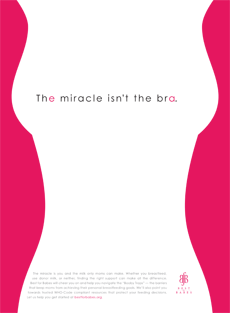
 @BestforBabes
@BestforBabes Best For Babes
Best For Babes


